Experimental Study of the Effects of Initial Ullage Height and Water Layer Thickness on Crude Oil Boilover Characteristics
Abstract
:1. Introduction
2. Experimental Details
2.1. Crude Oil Parameters
2.2. Experimental Setup and Working Conditions
3. Results and Discussion
3.1. Burning Process
3.2. Burning Rate
3.2.1. Effect of Water Layer Thickness on the Mass Burning Rate
3.2.2. Effect of Initial Ullage Height on the Mass Burning Rate
3.3. Critical Temperature at the Oil–Water Interface
3.3.1. Effect of Water Layer Thickness on the Critical Temperature at the Oil–Water Interface
3.3.2. Effect of Initial Ullage Height on the Critical Temperature at the Oil–Water Interface
3.4. Boilover Onset Time
3.4.1. Effect of Water Layer Thickness on Boilover Onset Time
3.4.2. Effect of Initial Ullage Height on the Boilover Onset Time
3.5. Boilover Intensity
3.5.1. Effect of Water Layer Thickness on the Boilover Intensity
3.5.2. Effect of Initial Ullage Height on the Boilover Intensity
3.6. Hot Wave Propagation Rate
4. Conclusions
- (1)
- Boilover characteristics vary by crude oil type. Russian crude oil is a light crude oil with a high burning rate. Due to its low viscosity, it has a weaker restraining effect on bubbles, making it more difficult to reach the critical conditions for boilover. As a result, the boilover onset time is delayed and the boilover intensity is weak. Russian crude oil exhibits 2~3 distinct boilover events, with a duration exceeding 240 s. In contrast, Daqing crude oil typically has a boilover duration of no more than 110 s, while the highly viscous Jidong crude oil experiences a single short but intense boilover event.
- (2)
- The water layer creates a cooling effect. When the water layer thickness reaches 8 cm, the mass burning rates of Jidong, Russian, and Daqing crude oils decrease by 19.2%, 14.3%, and 23.3%, respectively, compared to the no-water-layer condition. The boilover onset time is delayed, and the boilover intensity fluctuates but gradually weakens. However, the cooling effect has a limit, with its influence diminishing when the water layer exceeds 6 cm. Ullage height affects flame behavior, and moderate increases promote combustion, shorten boilover onset time, and cause the critical oil–water interface temperature to vary nonlinearly between approximately 100 and 120 °C. Further increases suppress combustion, leading to self-extinction. It should be noted that in larger-scale or real tank fires, the flame turbulence is much greater, and the impact on the thermal conductivity of the tank walls is smaller. Many of these effects are not observed in the small-scale experiments, which is a limitation of this study.
- (3)
- The variation trends of the hot wave propagation rate with water layer thickness and ullage height are consistent with those of the burning rate. Based on the principle of material conservation, a relationship between the hot wave propagation rate and linear burning rate is established, and it is found that the two are proportional (). This hypothesis is further validated through experimental data.
Author Contributions
Funding
Institutional Review Board Statement
Informed Consent Statement
Data Availability Statement
Conflicts of Interest
References
- Shaluf, I.M.; Abdulla, S. An overview on ADCO crude oil storage tanks. Disaster Prev. Manag. 2010, 19, 370–383. [Google Scholar] [CrossRef]
- Wang, J.; Yang, R.; Gao, Z.; Ding, S.; Qin, L. Investigation of external fuel fire hazards of full-Scale aircraft fuselage under sub-atmospheric pressure. Fuel 2025, 380, 132950. [Google Scholar] [CrossRef]
- Hernandez, F.; Carcamo, L.; Hao, H.; Zhang, X.; Contreras, N.; Astroza, R. Analysis of fuel storage tanks under internal deflagrations with different venting technologies: An experimental and numerical study. Eng. Fail. Anal. 2025, 167, 108948. [Google Scholar] [CrossRef]
- Liu, C.; Yin, Z.; Jangi, M.; Zhu, X.; Liu, Y.; Zhang, R.; Huang, P.; Yu, L. Experimental study on radiative heat flux from annular pool fires under the cross airflow. Appl. Therm. Eng. 2025, 260, 124947. [Google Scholar] [CrossRef]
- Qi, S.; Shuai, J.; Shi, L.; Li, Y.; Zhou, L. Quantitative risk assessment of leakage accident of crude oil storage tank based on fuzzy Bayesian network and improved AHP. J. Loss Prev. Process Ind. 2024, 90, 105341. [Google Scholar] [CrossRef]
- Ahmadi, O.; Mortazavi, S.B.; Mahabadi, H.A. Review of atmospheric storage tank fire scenarios: Costs and causes. J. Fail. Anal. Prev. 2020, 20, 384–405. [Google Scholar] [CrossRef]
- Wu, Z.; Hou, L.; Wu, S.; Wu, X.; Liu, F. The time-to-failure assessment of large crude oil storage tank exposed to pool fire. Fire Saf. J. 2020, 117, 103192. [Google Scholar] [CrossRef]
- Hasegawa, K. Experimental study on the mechanism of hot zone formation in open-tank fires. Fire Saf. Sci. 1989, 2, 221–230. [Google Scholar] [CrossRef]
- Broeckmann, B.; Schecker, H.G. Heat transfer mechanisms and boilover in burning oil-water systems. J. Loss Prev. Process Ind. 1995, 8, 137–147. [Google Scholar] [CrossRef]
- Laboureur, D.; Aprin, L.; Osmont, A.; Buchlin, J.M.; Rambaud, P. Small scale thin-layer boilover experiments: Physical understanding and modeling of the water sub-layer boiling and the flame enlargement. J. Loss Prev. Process Ind. 2013, 26, 1380–1389. [Google Scholar] [CrossRef]
- Kamarudin, W.N.I.W.; Buang, A. Small scale boilover and visualization of hot zone. J. Loss Prev. Process Ind. 2016, 44, 232–240. [Google Scholar] [CrossRef]
- Tseng, T.Y.; Wu, C.L.; Tsai, K.C. Effect of bubble generation on hot zone formation in tank fires. J. Loss Prev. Process Ind. 2020, 68, 104314. [Google Scholar] [CrossRef]
- Chen, Q.; Liu, X.; Wang, X.; Zhao, J.; Zhou, T.; Ding, C. Experimental study of liquid fuel boilover behavior in normal and low pressures. Fire Mater. 2018, 42, 843–858. [Google Scholar] [CrossRef]
- Zhao, J.; Zhang, Q.; Wang, Z.; Yang, R.; Zhang, J. Continuous boilover behaviors of large-scale kerosene pool fires under sub-atmospheric pressure. Process Saf. Environ. Prot. 2023, 177, 1431–1439. [Google Scholar] [CrossRef]
- Zhao, J.; Zhang, Q.; Hu, Z.; Kang, R.; Jomaas, G.; Yang, R. Thin-layer boilover of large-scale diesel pool fires at sub-atmospheric pressure. Fuel 2024, 360, 130482. [Google Scholar] [CrossRef]
- Kong, D.; Liu, P.; Zhang, J.; Fan, M.; Tao, C. Small scale experiment study on the characteristics of boilover. J. Loss Prev. Process Ind. 2017, 48, 101–110. [Google Scholar] [CrossRef]
- Ping, P.; He, X.; Kong, D.; Wen, R.; Zhang, Z.; Liu, P. An experimental investigation of burning rate and flame tilt of the boilover fire under cross air flows. Appl. Therm. Eng. 2018, 133, 501–511. [Google Scholar] [CrossRef]
- Ping, P.; Zhang, J.; Kong, D.; Xu, Z.; Yang, H. Experimental study of the flame geometrical characteristics of the crude oil boilover fire under cross air flow. J. Loss Prev. Process Ind. 2018, 55, 500–511. [Google Scholar] [CrossRef]
- Li, Y.; Luan, G.; Jing, Q.; Li, X.; Yan, C.; Li, Y.; Zhang, L. Experimental study of the effect of crude oil water content on boilover fire. Int. J. Therm. Sci. 2024, 206, 109328. [Google Scholar] [CrossRef]
- Luan, G.; Li, Y.; Li, X.; Yan, C.; Zhang, Y.; Zhang, B.; Ma, G.; Li, Y.; Jing, Q. Experimental study on boilover fire characteristics and uncertainty of high water-content crude oil. J. Loss Prev. Process Ind. 2025, 94, 105553. [Google Scholar] [CrossRef]
- Yang, S.; Pu, F.; Zhang, L.; Li, M.; Li, J. Experimental study on combustion characteristics of water-in-oil emulsified diesel pool fire with water sublayer. Appl. Therm. Eng. 2024, 238, 121932. [Google Scholar] [CrossRef]
- Koseki, H.; Natsume, Y.; Iwata, Y.; Takahashi, T.; Hirano, T. Large-scale boilover experiments using crude oil. Fire Saf. J. 2006, 41, 529–535. [Google Scholar] [CrossRef]
- Shaluf, I.M.; Abdullah, S.A. Floating roof storage tank boilover. J. Loss Prev. Process Ind. 2011, 24, 1–7. [Google Scholar] [CrossRef]
- Fan, W.; Hua, J.; Liao, G. Experimental study on the premonitory phenomena of boilover in liquid pool fires supported on water. J. Loss Prev. Process Ind. 1995, 8, 221–227. [Google Scholar] [CrossRef]
- Hua, J.; Fan, W.; Liao, G. Study and prediction of boilover in liquid pool fires with a water sublayer using micro-explosion noise phenomena. Fire Saf. J. 1998, 30, 269–291. [Google Scholar] [CrossRef]
- Tseng, T.Y.; Tsai, K.C. Hot-zone boilover suppression using floating objects in crude oil tank fires. Fire Saf. J. 2020, 118, 103239. [Google Scholar] [CrossRef]
- Liu, C.; Ding, L.; Jangi, M.; Ji, J.; Yu, L.; Wan, H. Experimental study of the effect of ullage height on flame characteristics of pool fires. Combust. Flame 2020, 216, 245–255. [Google Scholar] [CrossRef]
- Zhang, X.; Zhao, J.; Li, X.; Huang, H.; Zhang, J. Experimental investigation of effects of ullage height on the burning rate and heat feedback in pool fires. Case Stud. Therm. Eng. 2024, 62, 105175. [Google Scholar] [CrossRef]
- Zhao, J.; Zhang, S.; Pan, Y.; Hu, Z.; Zhang, J. Experimental investigation and theoretical analysis of effects of crosswind on flame lengths and tilting behaviors of pool fires with large ullage heights. Fuel 2025, 388, 134453. [Google Scholar] [CrossRef]
- Jing, Q.; Yan, C.; Luan, G.; Li, Y.; Zhang, L.; Li, Y.; Li, X.; Zhang, Y.; Song, X. Mechanisms of water layer thickness and ullage height on crude oil boilover: A theoretical model coupling the effects of multiple physical fields. Pet. Sci. 2024, 21, 4405–4416. [Google Scholar] [CrossRef]
- Guo, Y.; Xiao, G.; Deng, H.; Wang, L.; Lei, Z.; Chen, Y. Characterizing Boilover Behaviours in Thin-Layer Diesel Pool Fires: The Critical Roles of Lip Height and Water Layer Thickness. Fire Saf. J. 2025, 152, 104345. [Google Scholar] [CrossRef]
- Li, Y.; Xu, D.; Huang, H.; Zhao, J.; Shuai, J. An experimental study on the burning rate of a continuously released n-heptane spill fire on an open water surface. J. Loss Prev. Process Ind. 2020, 63, 104033. [Google Scholar] [CrossRef]
- Zhao, J.; Zhang, J.; Chen, C.; Huang, H.; Yang, R. Experimental investigation on the burning behaviors of thin-layer transformer oil on a water layer. Process Saf. Environ. Prot. 2020, 139, 89–97. [Google Scholar] [CrossRef]
- Zhao, J.; He, Y.; Xiao, J.; Su, Z.; Ma, H.; Zhai, X. Experimental Investigation of the Spread and Burning Behaviors of Diesel Spill Fires on a Water Surface. Fire 2024, 7, 402. [Google Scholar] [CrossRef]
- Ditch, B.D.; de Ris, J.L.; Blanchat, T.K.; Chaos, M.; Bill, R.G., Jr.; Dorofeev, S.B. Pool fires—An empirical correlation. Combust. Flame 2013, 160, 2964–2974. [Google Scholar] [CrossRef]
- Babrauskas, V. Estimating large pool fire burning rates. Fire Technol. 1983, 19, 251–261. [Google Scholar] [CrossRef]
- Zhao, J.; Zhang, X.; Zhang, J.; Wang, W.; Chen, C. Experimental study on the flame length and burning behaviors of pool fires with different ullage heights. Energy 2022, 246, 123397. [Google Scholar] [CrossRef]
- Zhao, J.; Zhang, X.; Song, G.; Huang, H.; Zhang, J. Experiments and modeling of the temperature profile of turbulent diffusion flames with large ullage heights. Fuel 2023, 331, 125876. [Google Scholar] [CrossRef]
- Garo, J.P.; Vantelon, J.P.; Koseki, H. Thin-layer boilover: Prediction of its onset and intensity. Combust. Sci. Technol. 2006, 178, 1217–1235. [Google Scholar] [CrossRef]
- Guo, Y.; Xiao, G.; Chen, J.; Deng, H.; Liu, X.; Wang, L.; Xiong, X. Mini but Mighty: Oscillations in diffusion flames at sub-atmospheric conditions. Fuel 2024, 360, 130571. [Google Scholar] [CrossRef]
- Ahmadi, O.; Mortazavi, S.B. Prediction of time to Boilover in crude oil storage tanks using empirical models. Iran Occup. Health 2020, 17, 697–711. [Google Scholar]
- Ahmadi, O.; Mortazavi, S.B.; Pasdarshahri, H.; Pasdarshahri, H.; Mahabadi, H.A.; Sarvestani, K. Modeling of boilover phenomenon consequences: Computational fluid dynamics (CFD) and empirical correlations. Process Saf. Environ. Prot. 2019, 129, 25–39. [Google Scholar] [CrossRef]
- Ferrero, F.; Muñoz, M.; Kozanoglu, B.; Casal, J.; Arnaldos, J. Experimental study of thin-layer boilover in large-scale pool fires. J. Hazard. Mater. 2006, 137, 1293–1302. [Google Scholar] [CrossRef]
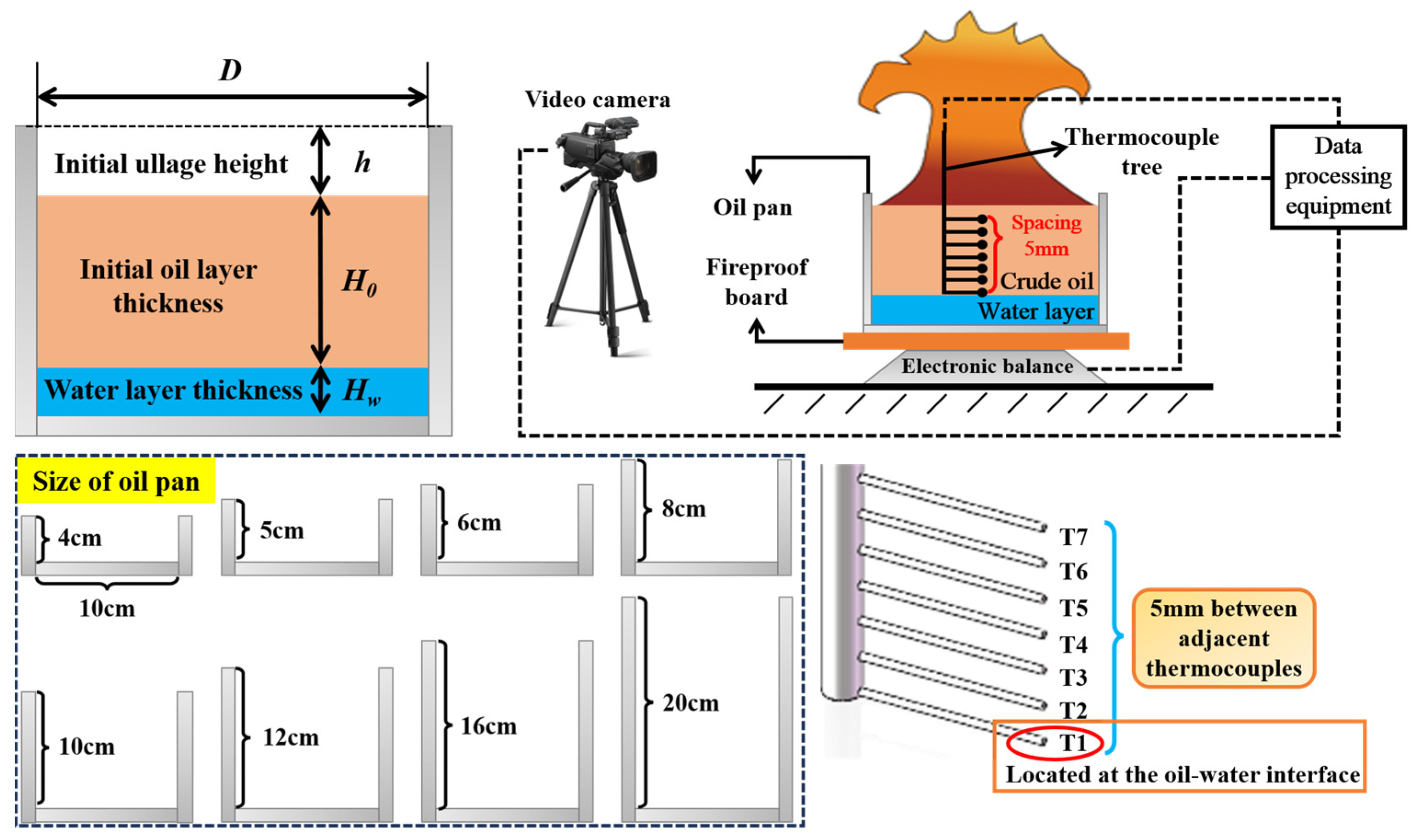

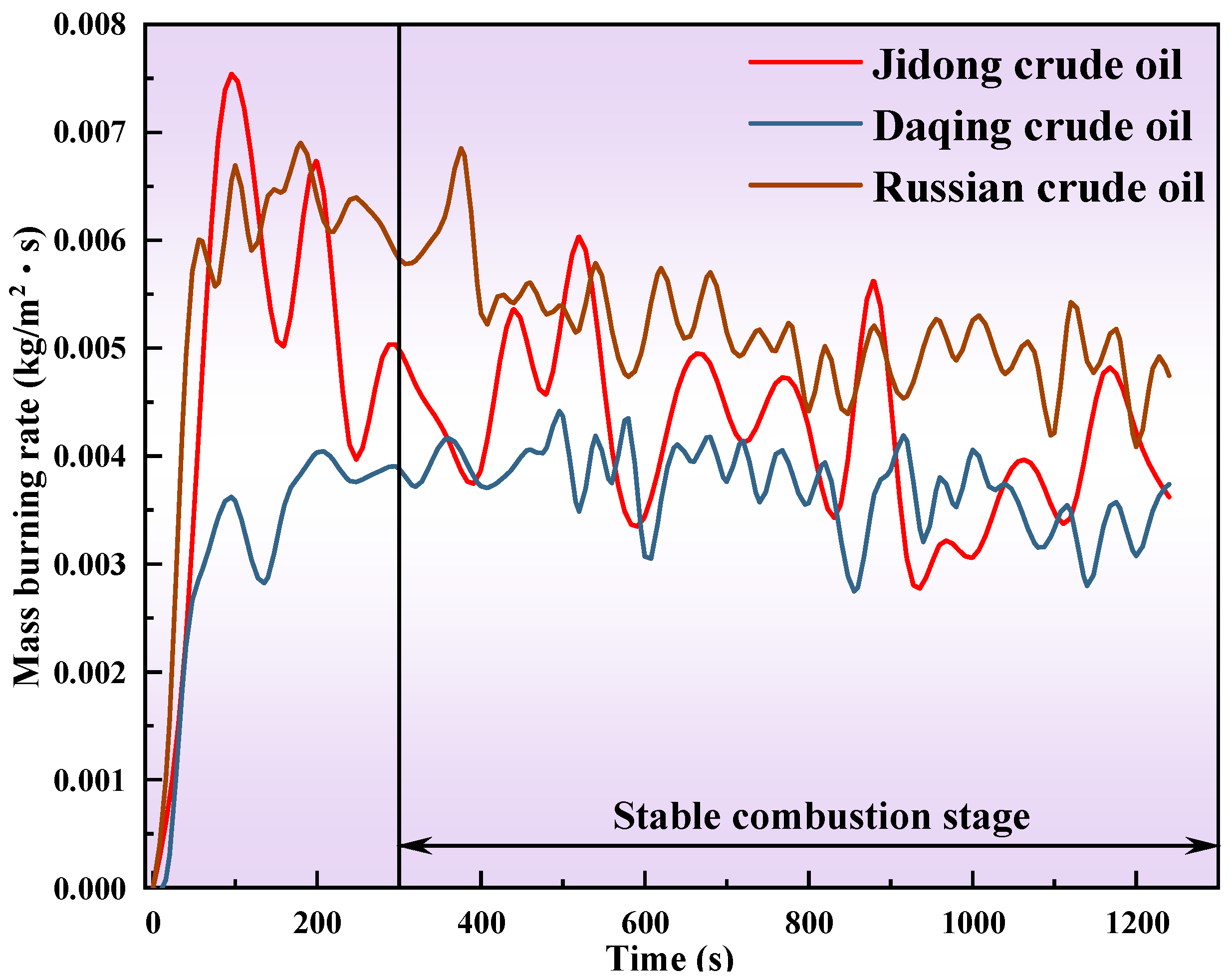
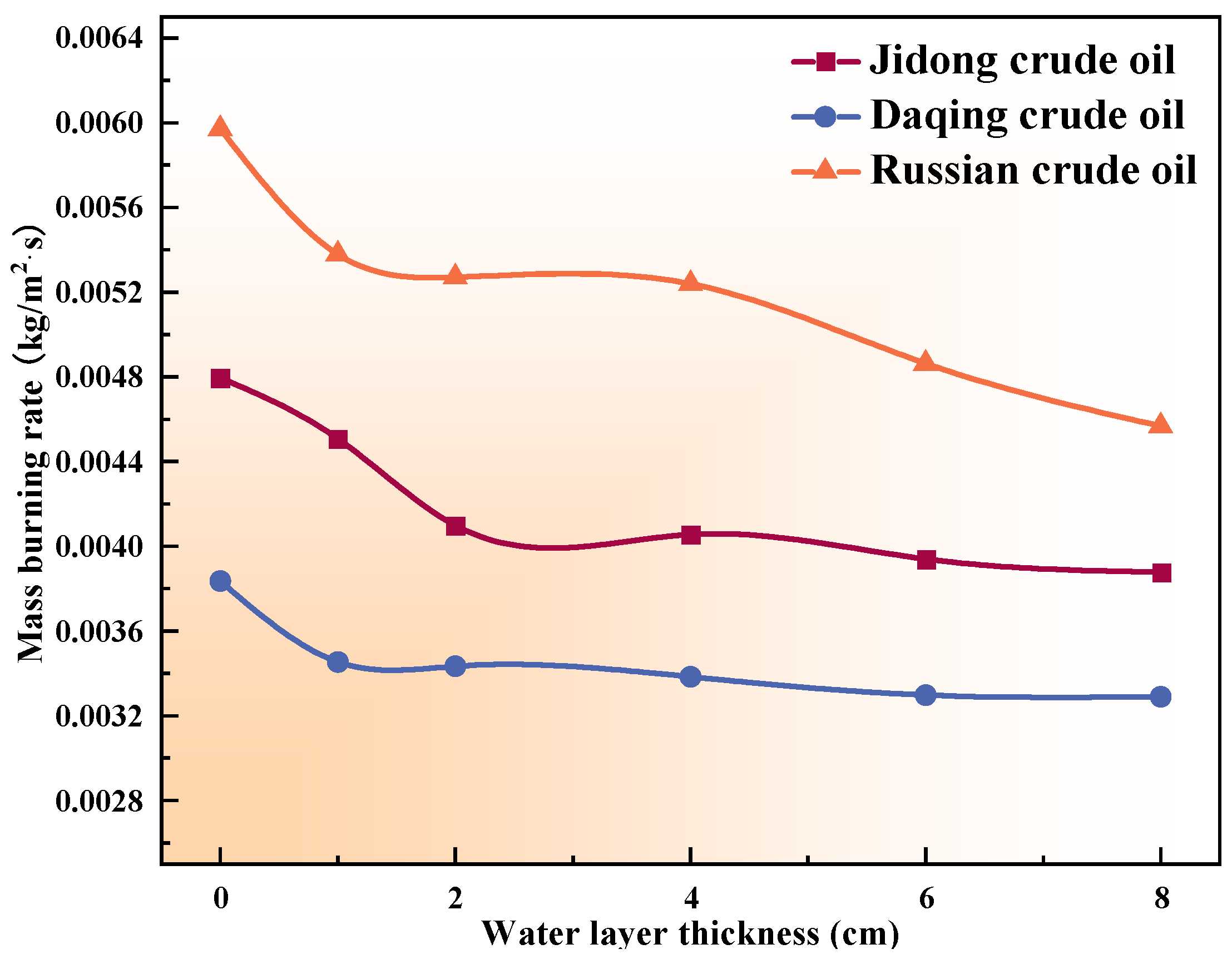

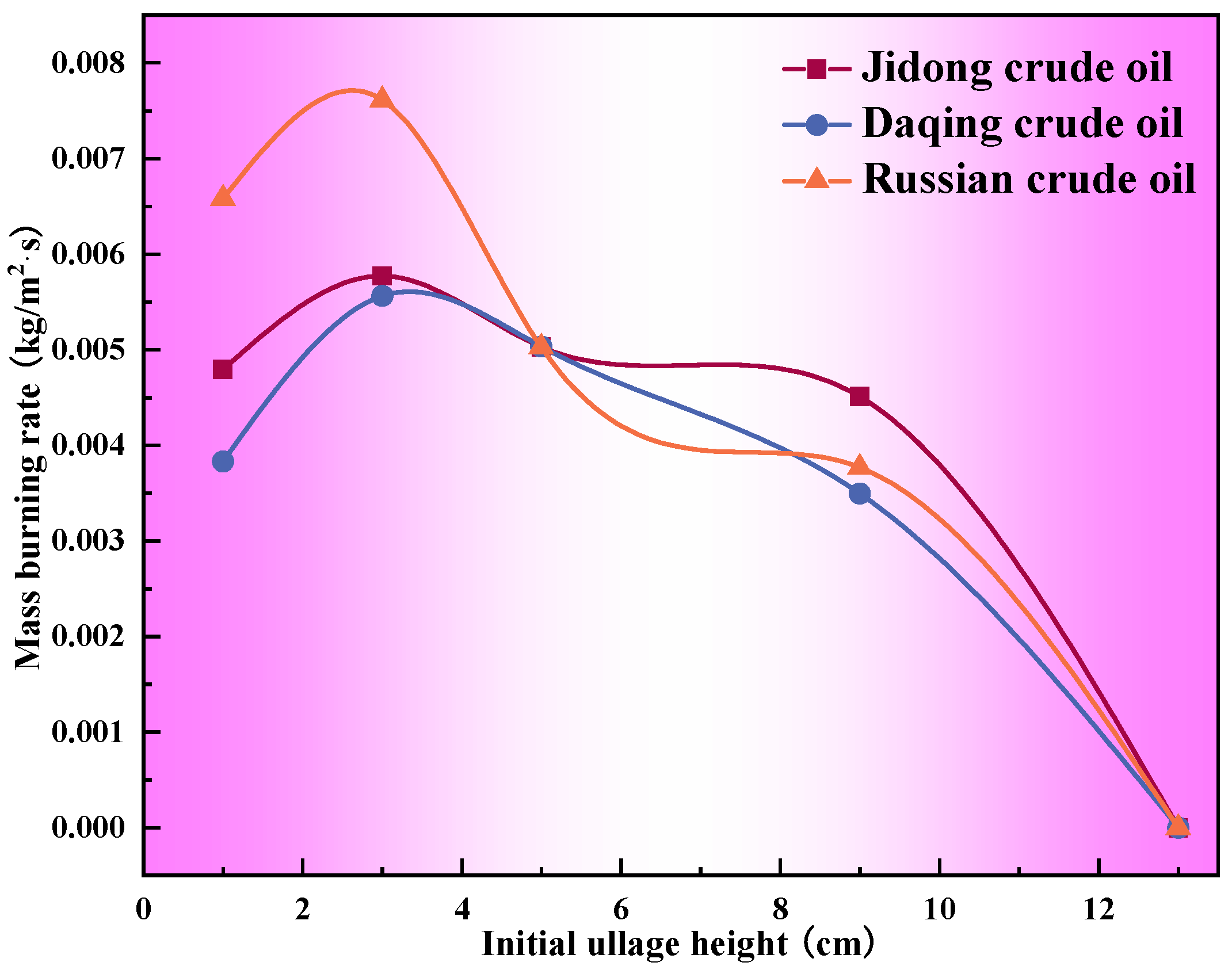

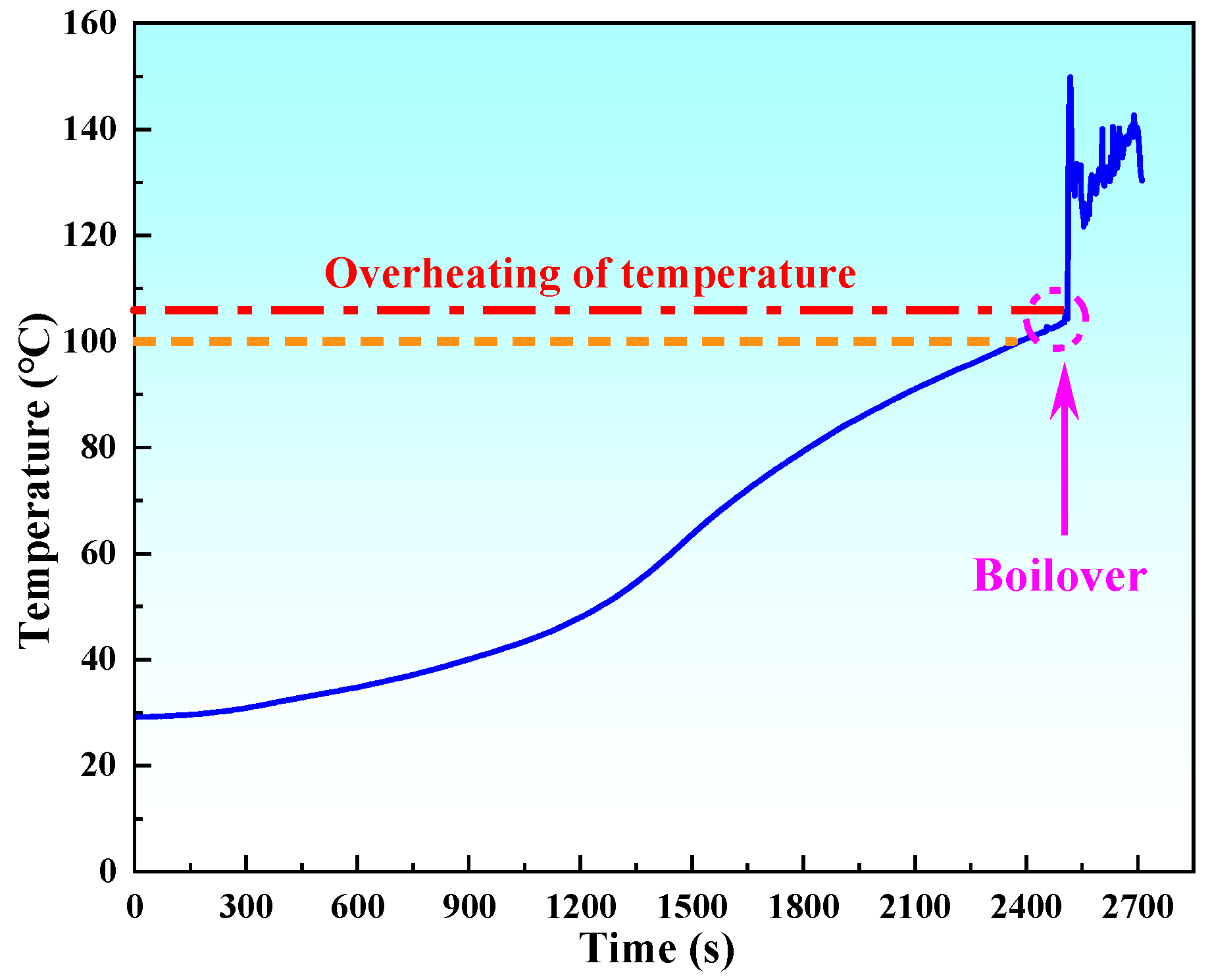
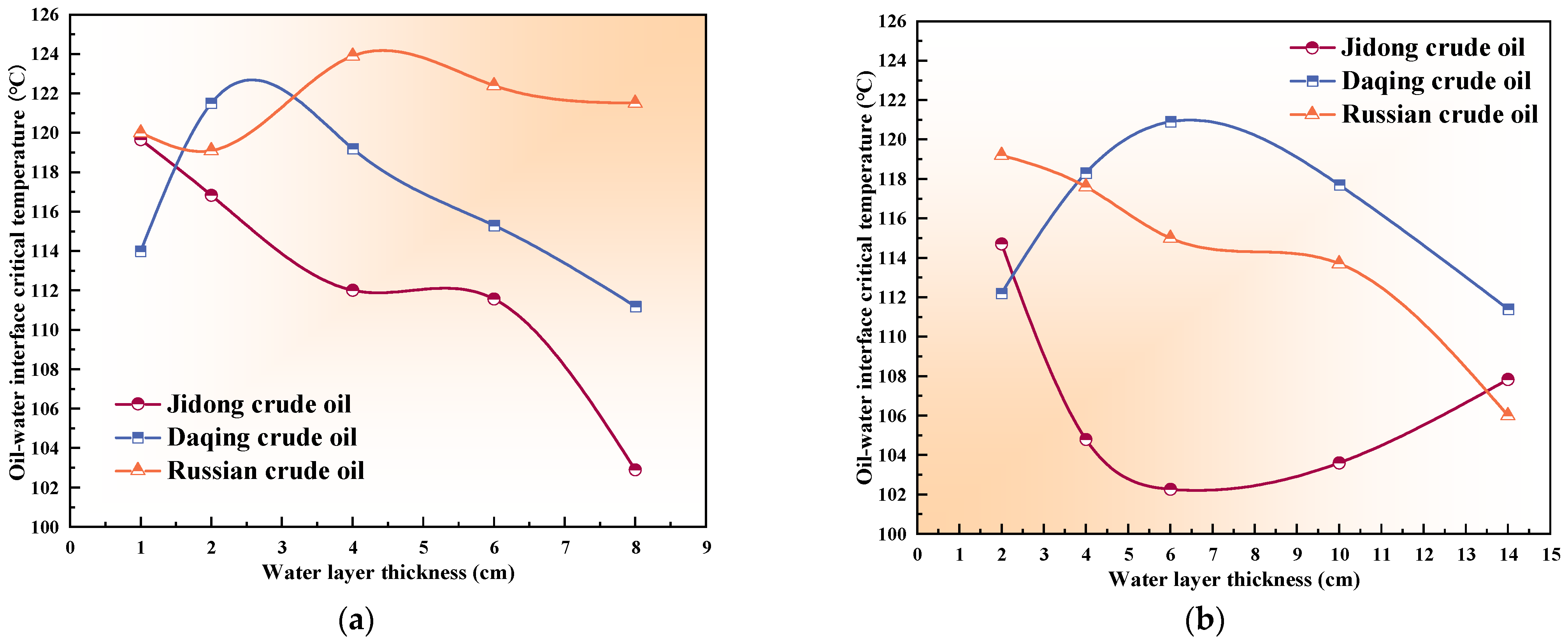
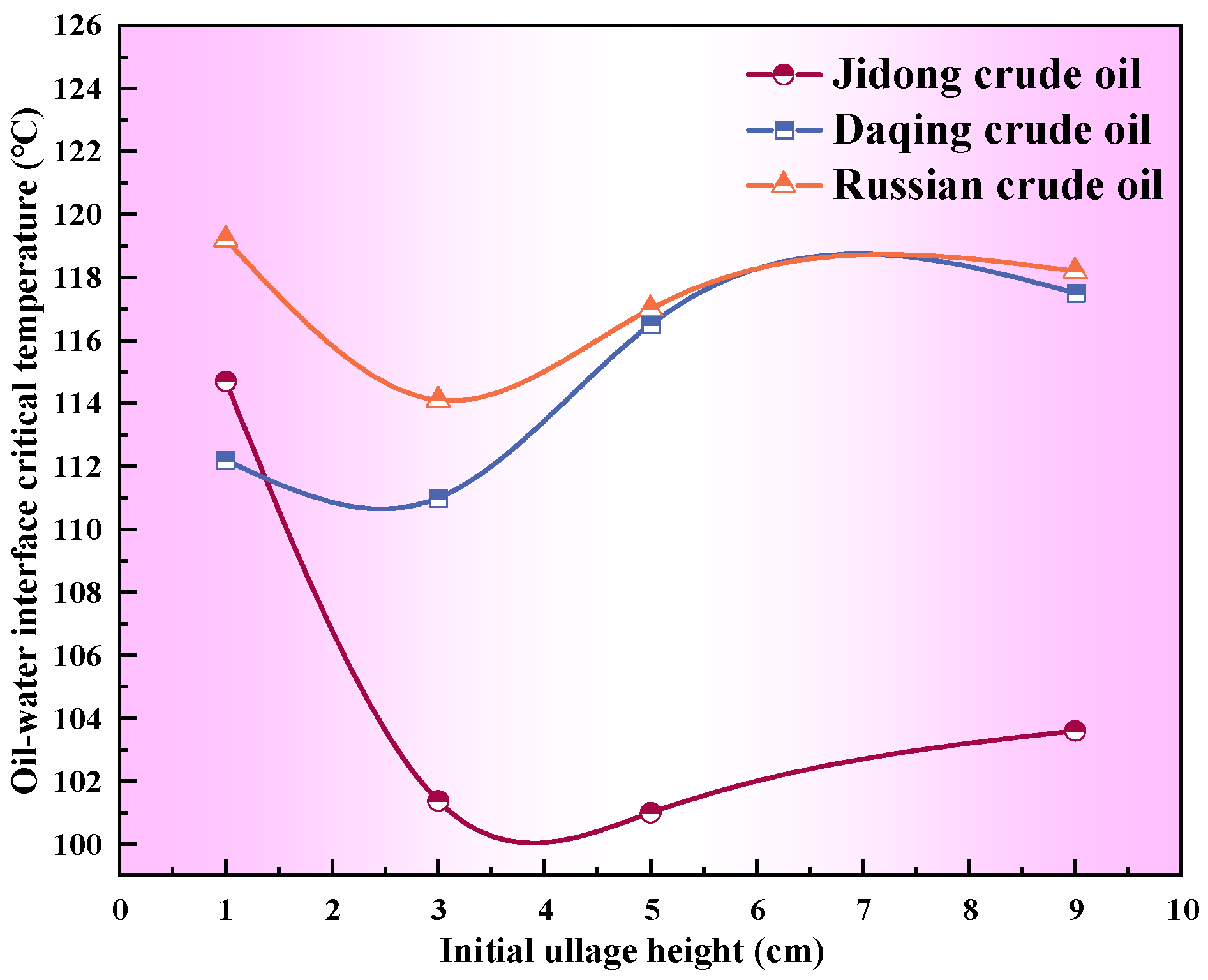
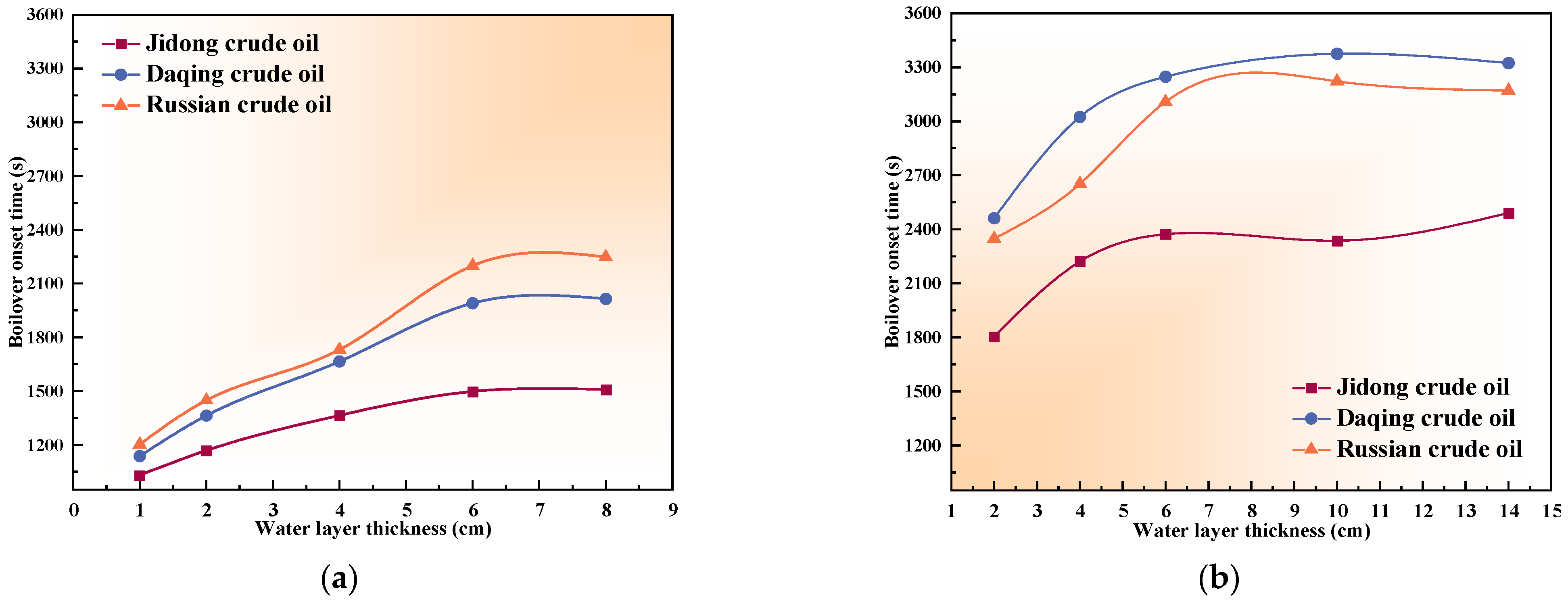
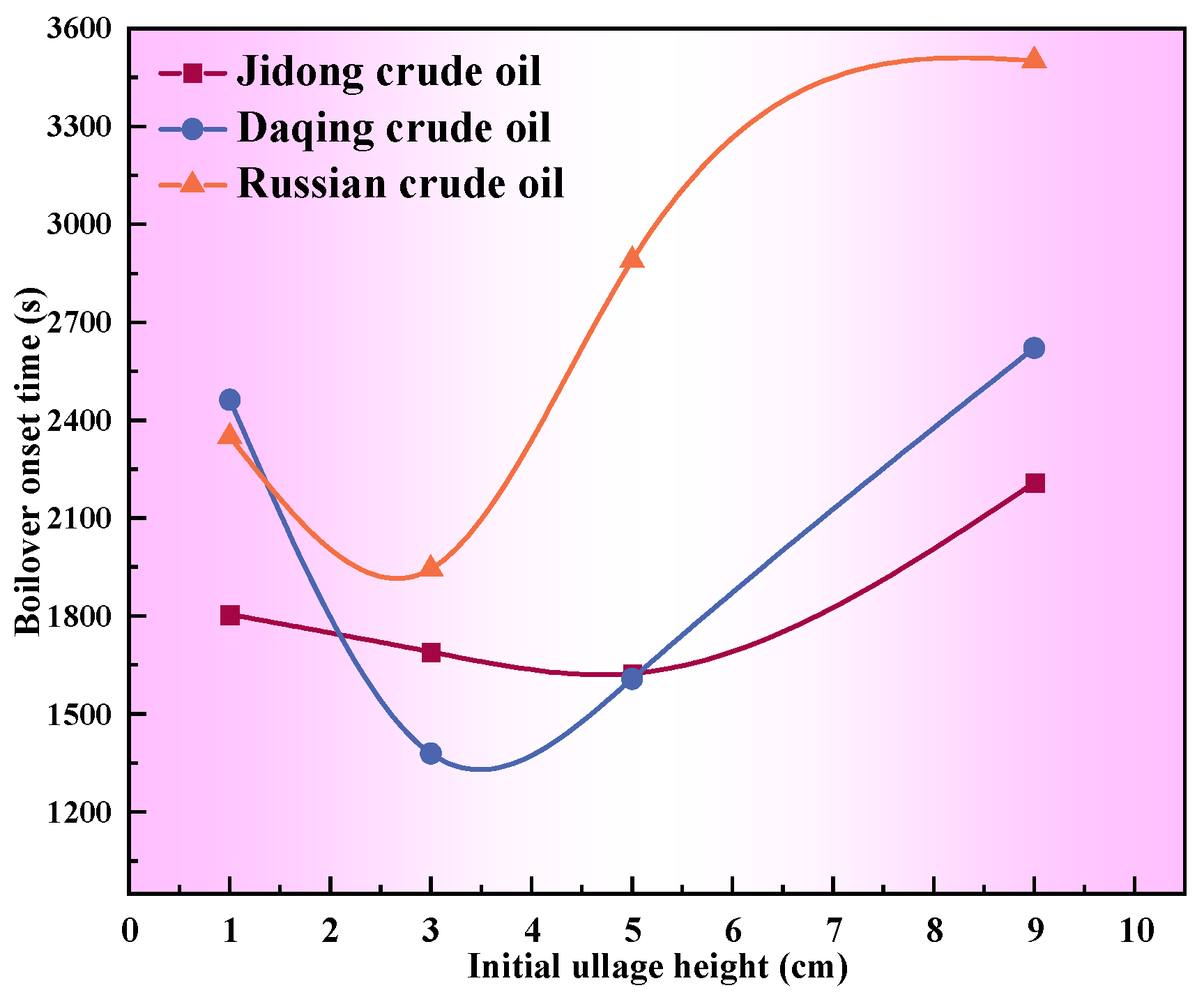

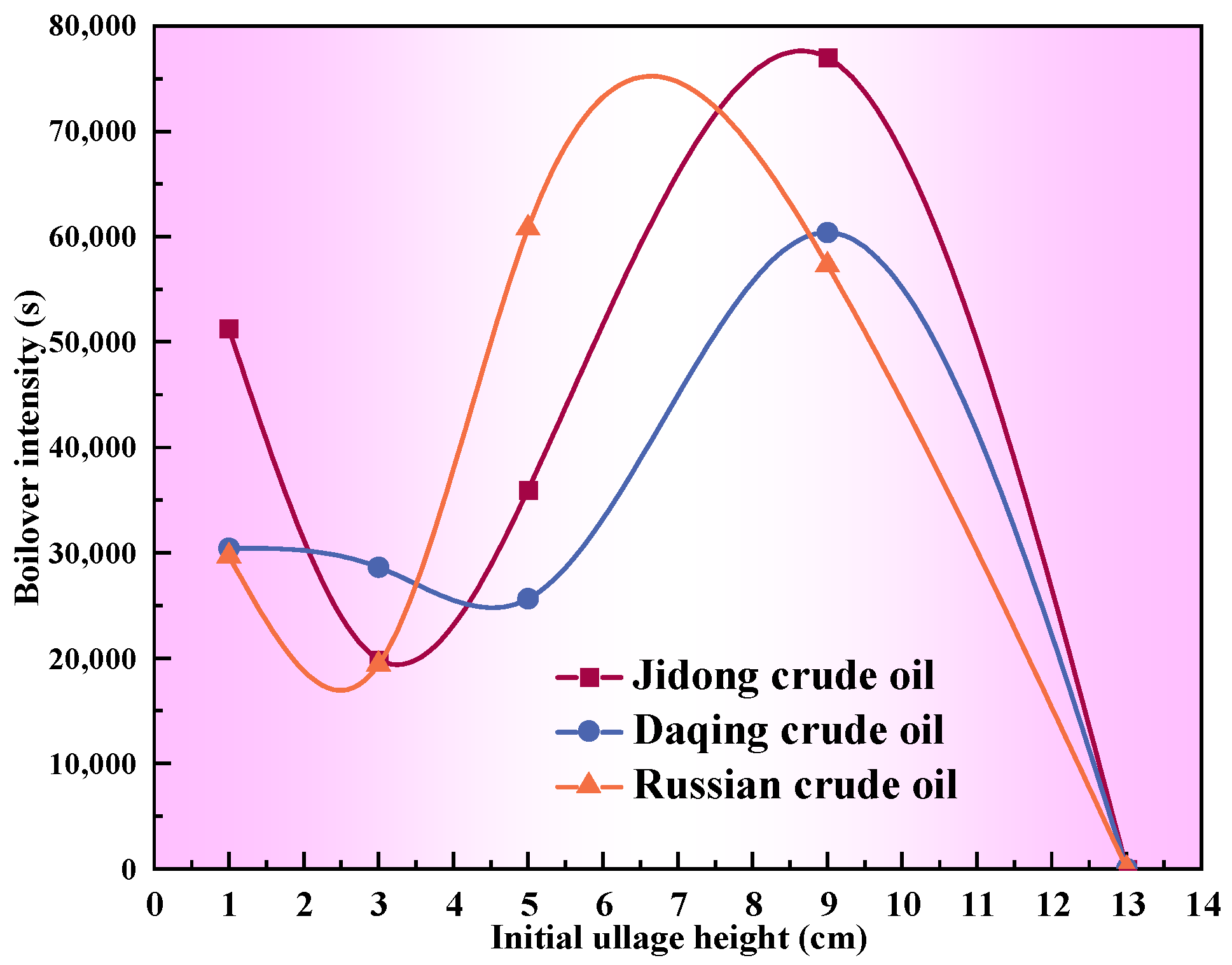
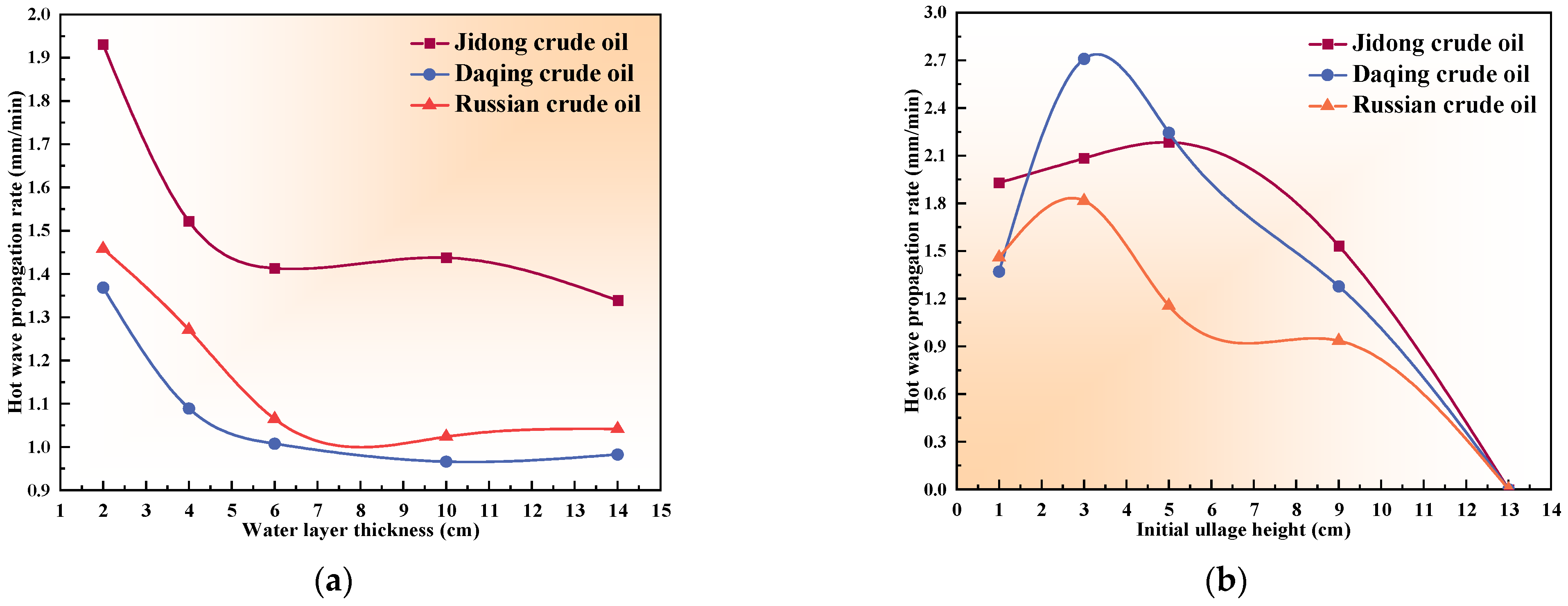
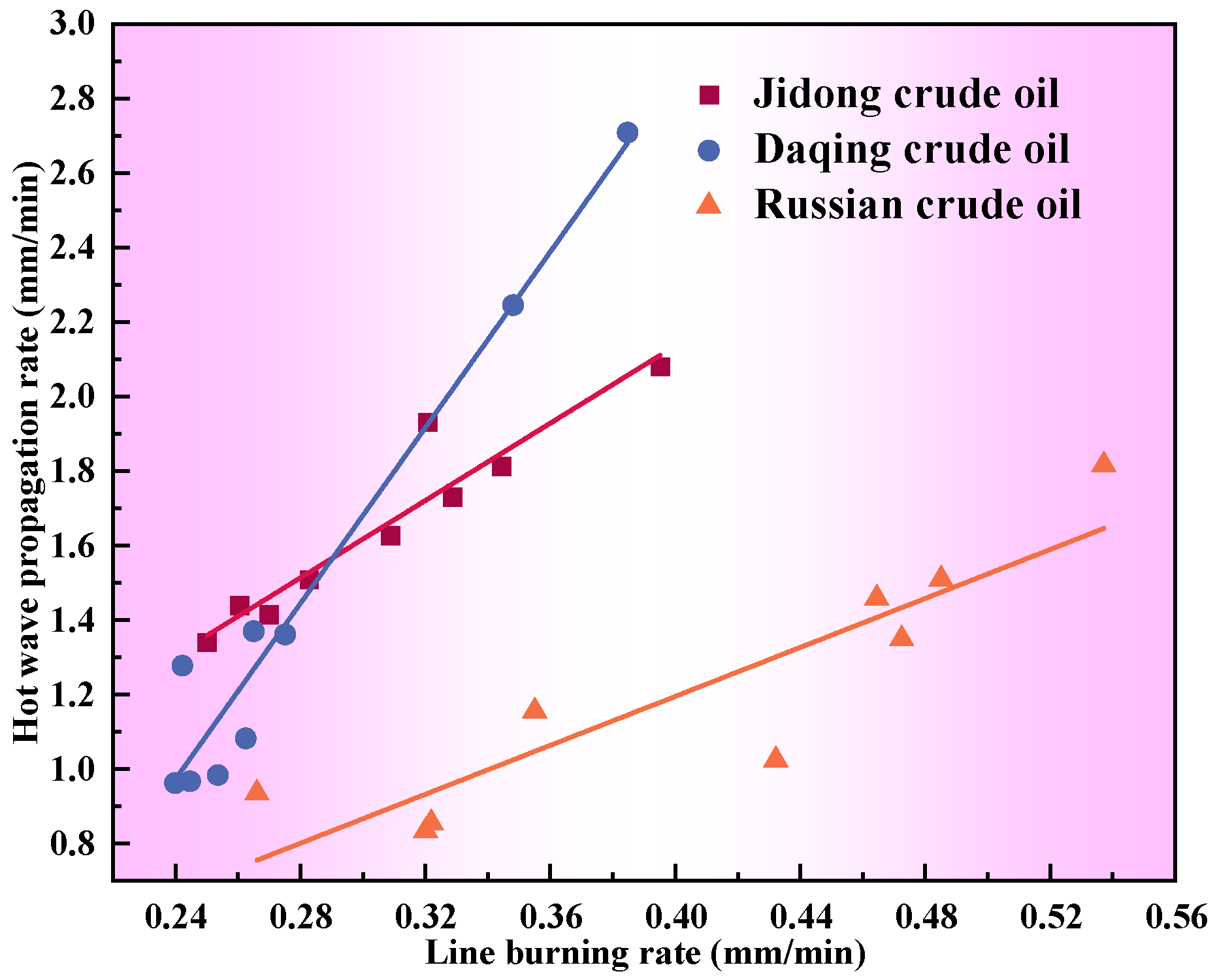
| Crude Oil Parameter | Jidong Crude Oil | Daqing Crude Oil | Russian Crude Oil |
|---|---|---|---|
| Density—20 °C (g/m3) | 0.876 | 0.867 | 0.850 |
| Viscosity—20 °C (mPa·s) | 32.29 | 25.48 | 4.294 |
| Water content (%) | 0.26 | 0.01 | 0.00 |
| Average freezing point (°C) | 28 | 15 | / |
| Average sulfur content (%) | / | 0.212 | 0.832 |
| Pool Diameter, D (cm) | Initial Oil Layer Thickness, H0 (cm) | Initial Ullage Thickness, h (cm) | Water Layer Thickness, Hw (cm) |
|---|---|---|---|
| 10 | 3 | 1 | 0, 1, 2, 4, 6, 8 |
| 5 | 1 | 0, 2, 4, 6, 10, 14 | |
| 5 | 1, 3, 5, 9, 13 | 2 |
| Parameter | Russian Crude Oil | Jidong Crude Oil | Daqing Crude Oil |
|---|---|---|---|
| Mass burning rate (kg/m2·s) | 6.0 × 10⁻3 | 4.8 × 10⁻3 | 3.9 × 10⁻3 |
| Type of Crude Oil | Water Layer Thickness | Average Number of Boilover | Average Boilover Duration |
|---|---|---|---|
| Daqing crude oil | 1 cm | 1 | 40 s |
| 2 cm | 1 | 69 s | |
| 4 cm | 2.7 | 107 s | |
| 6 cm | 2.3 | 70 s | |
| 8 cm | 1.7 | 95 s | |
| Russian crude oil | 1 cm | 2.7 | 285 s |
| 2 cm | 2 | 246 s | |
| 4 cm | 2 | 243 s | |
| 6 cm | 3 | 304 s | |
| 8 cm | 2 | 293 s |
| Type of Crude Oil | Parameters | Ullage Height | ||||
|---|---|---|---|---|---|---|
| 1 cm | 3 cm | 5 cm | 9 cm | 13 cm | ||
| Jidong crude oil | Boilover onset time | 1805 s | 1690 s | 1624 s | 2208 s | Self-extinguish |
| Boilover intensity | 51,262% | 19,882% | 35,983% | 76,995% | ||
| Daqing crude oil | Boilover onset time | 2463 s | 1380 s | 1608 s | 2621 s | Self-extinguish |
| Boilover intensity | 30,432% | 28,602% | 25,621% | 60,392% | ||
| Russian crude oil | Boilover onset time | 2349 s | 1944 s | 2890 s | 3502 s | Self-extinguish |
| Boilover intensity | 29,677% | 19,372% | 60,797% | 57,290% | ||
Disclaimer/Publisher’s Note: The statements, opinions and data contained in all publications are solely those of the individual author(s) and contributor(s) and not of MDPI and/or the editor(s). MDPI and/or the editor(s) disclaim responsibility for any injury to people or property resulting from any ideas, methods, instructions or products referred to in the content. |
© 2025 by the authors. Licensee MDPI, Basel, Switzerland. This article is an open access article distributed under the terms and conditions of the Creative Commons Attribution (CC BY) license (https://creativecommons.org/licenses/by/4.0/).
Share and Cite
Li, Y.; Yan, C.; Jing, Q.; Luan, G.; Li, X.; Li, Y.; Zhang, Y.; Zhang, B.; Ma, G. Experimental Study of the Effects of Initial Ullage Height and Water Layer Thickness on Crude Oil Boilover Characteristics. Fire 2025, 8, 78. https://doi.org/10.3390/fire8020078
Li Y, Yan C, Jing Q, Luan G, Li X, Li Y, Zhang Y, Zhang B, Ma G. Experimental Study of the Effects of Initial Ullage Height and Water Layer Thickness on Crude Oil Boilover Characteristics. Fire. 2025; 8(2):78. https://doi.org/10.3390/fire8020078
Chicago/Turabian StyleLi, Yueyang, Cong Yan, Qi Jing, Guohua Luan, Xin Li, Yuntao Li, Yunhe Zhang, Binglu Zhang, and Guangbo Ma. 2025. "Experimental Study of the Effects of Initial Ullage Height and Water Layer Thickness on Crude Oil Boilover Characteristics" Fire 8, no. 2: 78. https://doi.org/10.3390/fire8020078
APA StyleLi, Y., Yan, C., Jing, Q., Luan, G., Li, X., Li, Y., Zhang, Y., Zhang, B., & Ma, G. (2025). Experimental Study of the Effects of Initial Ullage Height and Water Layer Thickness on Crude Oil Boilover Characteristics. Fire, 8(2), 78. https://doi.org/10.3390/fire8020078





